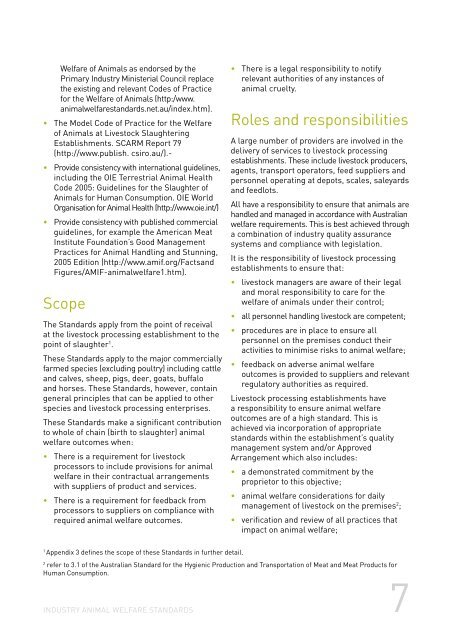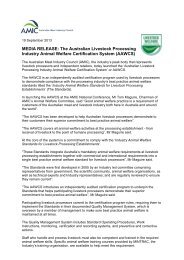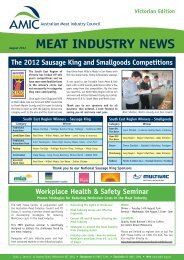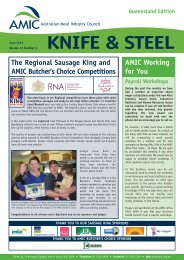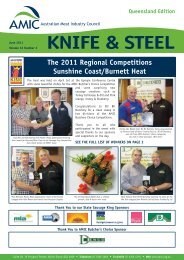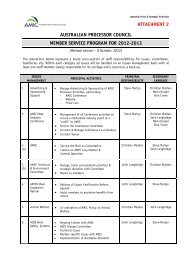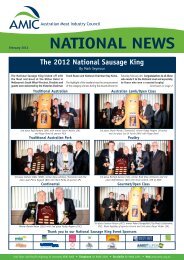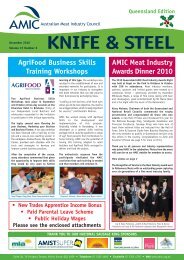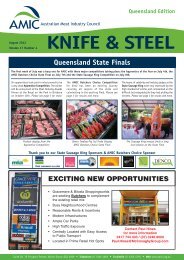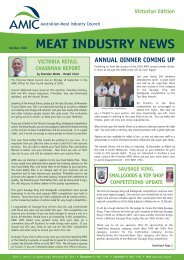Animal Welfare Standards - Australian Meat Industry Council
Animal Welfare Standards - Australian Meat Industry Council
Animal Welfare Standards - Australian Meat Industry Council
You also want an ePaper? Increase the reach of your titles
YUMPU automatically turns print PDFs into web optimized ePapers that Google loves.
<strong>Welfare</strong> of <strong>Animal</strong>s as endorsed by the<br />
Primary <strong>Industry</strong> Ministerial <strong>Council</strong> replace<br />
the existing and relevant Codes of Practice<br />
for the <strong>Welfare</strong> of <strong>Animal</strong>s (http:/www.<br />
animalwelfarestandards.net.au/index.htm).<br />
• The Model Code of Practice for the <strong>Welfare</strong><br />
of <strong>Animal</strong>s at Livestock Slaughtering<br />
Establishments. SCARM Report 79<br />
(http://www.publish. csiro.au/).-<br />
• Provide consistency with international guidelines,<br />
including the OIE Terrestrial <strong>Animal</strong> Health<br />
Code 2005: Guidelines for the Slaughter of<br />
<strong>Animal</strong>s for Human Consumption. OIE World<br />
Organisation for <strong>Animal</strong> Health (http://www.oie.int/)<br />
• Provide consistency with published commercial<br />
guidelines, for example the American <strong>Meat</strong><br />
Institute Foundation’s Good Management<br />
Practices for <strong>Animal</strong> Handling and Stunning,<br />
2005 Edition (http://www.amif.org/Factsand<br />
Figures/AMIF-animalwelfare1.htm).<br />
Scope<br />
The <strong>Standards</strong> apply from the point of receival<br />
at the livestock processing establishment to the<br />
point of slaughter 1 .<br />
These <strong>Standards</strong> apply to the major commercially<br />
farmed species (excluding poultry) including cattle<br />
and calves, sheep, pigs, deer, goats, buffalo<br />
and horses. These <strong>Standards</strong>, however, contain<br />
general principles that can be applied to other<br />
species and livestock processing enterprises.<br />
These <strong>Standards</strong> make a significant contribution<br />
to whole of chain (birth to slaughter) animal<br />
welfare outcomes when:<br />
• There is a requirement for livestock<br />
processors to include provisions for animal<br />
welfare in their contractual arrangements<br />
with suppliers of product and services.<br />
• There is a requirement for feedback from<br />
processors to suppliers on compliance with<br />
required animal welfare outcomes.<br />
1 Appendix 3 defines the scope of these <strong>Standards</strong> in further detail.<br />
• There is a legal responsibility to notify<br />
relevant authorities of any instances of<br />
animal cruelty.<br />
Roles and responsibilities<br />
A large number of providers are involved in the<br />
delivery of services to livestock processing<br />
establishments. These include livestock producers,<br />
agents, transport operators, feed suppliers and<br />
personnel operating at depots, scales, saleyards<br />
and feedlots.<br />
All have a responsibility to ensure that animals are<br />
handled and managed in accordance with <strong>Australian</strong><br />
welfare requirements. This is best achieved through<br />
a combination of industry quality assurance<br />
systems and compliance with legislation.<br />
It is the responsibility of livestock processing<br />
establishments to ensure that:<br />
• livestock managers are aware of their legal<br />
and moral responsibility to care for the<br />
welfare of animals under their control;<br />
• all personnel handling livestock are competent;<br />
• procedures are in place to ensure all<br />
personnel on the premises conduct their<br />
activities to minimise risks to animal welfare;<br />
• feedback on adverse animal welfare<br />
outcomes is provided to suppliers and relevant<br />
regulatory authorities as required.<br />
Livestock processing establishments have<br />
a responsibility to ensure animal welfare<br />
outcomes are of a high standard. This is<br />
achieved via incorporation of appropriate<br />
standards within the establishment’s quality<br />
management system and/or Approved<br />
Arrangement which also includes:<br />
• a demonstrated commitment by the<br />
proprietor to this objective;<br />
• animal welfare considerations for daily<br />
management of livestock on the premises2 ;<br />
• verification and review of all practices that<br />
impact on animal welfare;<br />
2 refer to 3.1 of the <strong>Australian</strong> Standard for the Hygienic Production and Transportation of <strong>Meat</strong> and <strong>Meat</strong> Products for<br />
Human Consumption.<br />
7<br />
INDUSTRY ANIMAL WELFARE STANDARDS


